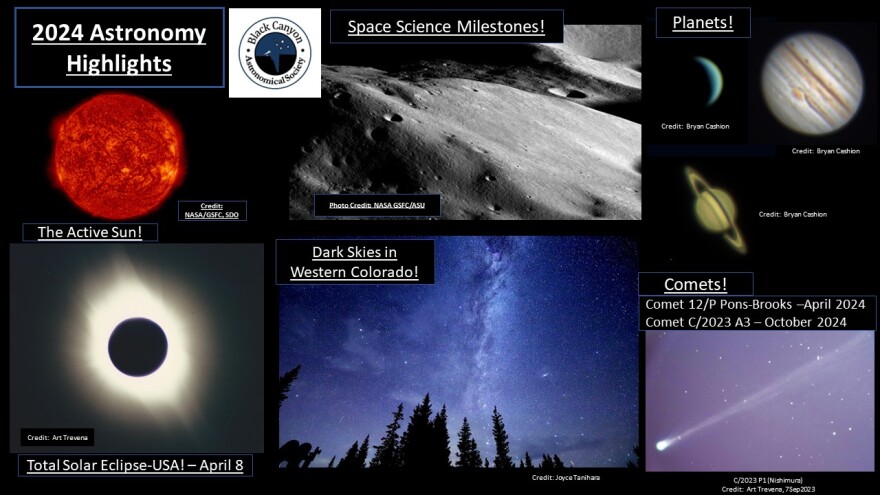2024 is almost here, and in astronomy, a lot will be happening.
The sun is approaching the peak of its 11-year activity cycle. Expect many sunspots, extreme solar flares, and coronal mass ejections of charged particles. This activity may trigger auroras, aka northern lights, and airglow, which may be visible from the Western Slope.
Although comet behavior is hard to predict, two comets may get very bright in 2024. Look for Comet 12P/Pons-Brooks in April. Then in October, Comet C/2023 A3 (Tsuchinshan-ATLAS) may get as bright as Venus! During dark morning hours from August 11 to 14, we can enjoy the Perseid Meteor Shower, when debris from Comet 109P/Swift-Tuttle enters our atmosphere.
On September 17, we in western Colorado can see a partial lunar eclipse shortly after sunset, when the Moon nicks the southernmost part of the Earth’s dark, umbral shadow.
In space science, look forward to more break-throughs from the James Webb Space Telescope. NASA’s Juno probe will have two encounters with Jupiter’s volcanic moon, Io. Two other space probes will be traveling towards Jupiter’s icy moons, continuing the search for alien life. NASA’s Commercial Lunar Payload Services project will kick into high gear with several missions that will explore our Moon’s south polar region. And NASA’s crewed Artemis-II mission may fly around the Moon late in 2024.
On April 8, we can experience the last total solar eclipse visible from the Lower 48 States until year 2044. The Moon’s umbral shadow, less than 120 miles wide, will cross Mexico, Texas, several southern and midwestern states, Pennsylvania, New York, parts of New England, and southeastern Canada. This will be a great chance to see the magnificent solar corona and the myriad other phenomena that make total solar eclipses so amazing. From western Colorado, the eclipse will be partial, with about 62% of the Sun’s face covered by the Moon. But to see the total eclipse, you need to travel to the narrow path of totality. Why should you travel when you can see a partial eclipse from Colorado? There are many reasons. But to echo General Albert Myer, co-founder of the National Weather Service, a total solar eclipse is “a vision magnificent beyond description.”
There will be many special astronomy events in 2024. But each month, do take advantage of our Western Slope’s dark skies, by viewing planetary groupings, the striking stars of winter, the galaxies of spring, the summer Milky Way, and the constellations and star clusters of autumn.
You’ve been listening to “Western Slope Skies”, produced by the Black Canyon Astronomical Society and KVNF Community Radio. I’m Art Trevena.




